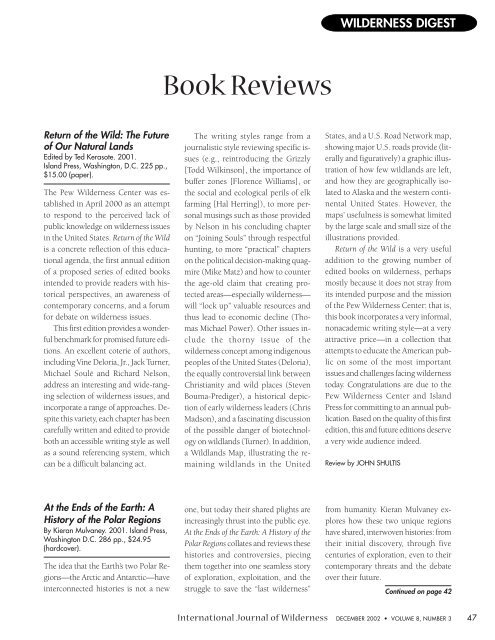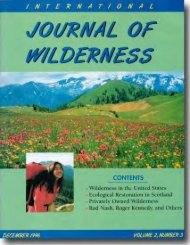Download full PDF - International Journal of Wilderness
Download full PDF - International Journal of Wilderness
Download full PDF - International Journal of Wilderness
Create successful ePaper yourself
Turn your PDF publications into a flip-book with our unique Google optimized e-Paper software.
Return <strong>of</strong> the Wild: The Future<br />
<strong>of</strong> Our Natural Lands<br />
Edited by Ted Kerasote. 2001.<br />
Island Press, Washington, D.C. 225 pp.,<br />
$15.00 (paper).<br />
The Pew <strong>Wilderness</strong> Center was established<br />
in April 2000 as an attempt<br />
to respond to the perceived lack <strong>of</strong><br />
public knowledge on wilderness issues<br />
in the United States. Return <strong>of</strong> the Wild<br />
is a concrete reflection <strong>of</strong> this educational<br />
agenda, the first annual edition<br />
<strong>of</strong> a proposed series <strong>of</strong> edited books<br />
intended to provide readers with historical<br />
perspectives, an awareness <strong>of</strong><br />
contemporary concerns, and a forum<br />
for debate on wilderness issues.<br />
This first edition provides a wonderful<br />
benchmark for promised future editions.<br />
An excellent coterie <strong>of</strong> authors,<br />
including Vine Deloria, Jr., Jack Turner,<br />
Michael Soulé and Richard Nelson,<br />
address an interesting and wide-ranging<br />
selection <strong>of</strong> wilderness issues, and<br />
incorporate a range <strong>of</strong> approaches. Despite<br />
this variety, each chapter has been<br />
care<strong>full</strong>y written and edited to provide<br />
both an accessible writing style as well<br />
as a sound referencing system, which<br />
can be a difficult balancing act.<br />
At the Ends <strong>of</strong> the Earth: A<br />
History <strong>of</strong> the Polar Regions<br />
By Kieran Mulvaney. 2001. Island Press,<br />
Washington D.C. 286 pp., $24.95<br />
(hardcover).<br />
The idea that the Earth’s two Polar Regions—the<br />
Arctic and Antarctic—have<br />
interconnected histories is not a new<br />
Book Reviews<br />
The writing styles range from a<br />
journalistic style reviewing specific issues<br />
(e.g., reintroducing the Grizzly<br />
[Todd Wilkinson], the importance <strong>of</strong><br />
buffer zones [Florence Williams], or<br />
the social and ecological perils <strong>of</strong> elk<br />
farming [Hal Herring]), to more personal<br />
musings such as those provided<br />
by Nelson in his concluding chapter<br />
on “Joining Souls” through respectful<br />
hunting, to more “practical” chapters<br />
on the political decision-making quagmire<br />
(Mike Matz) and how to counter<br />
the age-old claim that creating protected<br />
areas—especially wilderness—<br />
will “lock up” valuable resources and<br />
thus lead to economic decline (Thomas<br />
Michael Power). Other issues include<br />
the thorny issue <strong>of</strong> the<br />
wilderness concept among indigenous<br />
peoples <strong>of</strong> the United States (Deloria),<br />
the equally controversial link between<br />
Christianity and wild places (Steven<br />
Bouma-Prediger), a historical depiction<br />
<strong>of</strong> early wilderness leaders (Chris<br />
Madson), and a fascinating discussion<br />
<strong>of</strong> the possible danger <strong>of</strong> biotechnology<br />
on wildlands (Turner). In addition,<br />
a Wildlands Map, illustrating the remaining<br />
wildlands in the United<br />
one, but today their shared plights are<br />
increasingly thrust into the public eye.<br />
At the Ends <strong>of</strong> the Earth: A History <strong>of</strong> the<br />
Polar Regions collates and reviews these<br />
histories and controversies, piecing<br />
them together into one seamless story<br />
<strong>of</strong> exploration, exploitation, and the<br />
struggle to save the “last wilderness”<br />
WILDERNESS DIGEST<br />
States, and a U.S. Road Network map,<br />
showing major U.S. roads provide (literally<br />
and figuratively) a graphic illustration<br />
<strong>of</strong> how few wildlands are left,<br />
and how they are geographically isolated<br />
to Alaska and the western continental<br />
United States. However, the<br />
maps’ usefulness is somewhat limited<br />
by the large scale and small size <strong>of</strong> the<br />
illustrations provided.<br />
Return <strong>of</strong> the Wild is a very useful<br />
addition to the growing number <strong>of</strong><br />
edited books on wilderness, perhaps<br />
mostly because it does not stray from<br />
its intended purpose and the mission<br />
<strong>of</strong> the Pew <strong>Wilderness</strong> Center: that is,<br />
this book incorporates a very informal,<br />
nonacademic writing style—at a very<br />
attractive price—in a collection that<br />
attempts to educate the American public<br />
on some <strong>of</strong> the most important<br />
issues and challenges facing wilderness<br />
today. Congratulations are due to the<br />
Pew <strong>Wilderness</strong> Center and Island<br />
Press for committing to an annual publication.<br />
Based on the quality <strong>of</strong> this first<br />
edition, this and future editions deserve<br />
a very wide audience indeed.<br />
Review by JOHN SHULTIS<br />
from humanity. Kieran Mulvaney explores<br />
how these two unique regions<br />
have shared, interwoven histories: from<br />
their initial discovery, through five<br />
centuries <strong>of</strong> exploration, even to their<br />
contemporary threats and the debate<br />
over their future.<br />
Continued on page 42<br />
<strong>International</strong> <strong>Journal</strong> <strong>of</strong> <strong>Wilderness</strong> DECEMBER 2002 • VOLUME 8, NUMBER 3 47










